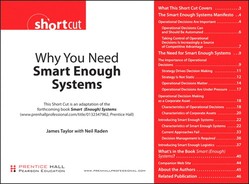Footnotes
Section 2
1 Many organizations are forced to change by changes in the business world, so this manifesto considers both for-profit and not-for-profit organizations.
2 Companies have employees, suppliers, partners, and customers. Government agencies might have employees, citizens, and regulated companies. All are considered associates of the organization.
Section 3
3 Opinion Research Corporation. “IT Professionals and Decision Automation.” A sample of 200 IT professionals at companies over $100 million in revenue including 40 CIOs/CTOs. Companies included Retail Banking, Credit Card, Mortgage, Property & Casualty, Health, and Life Insurance, Telecom, Retail, and Healthcare Providers. Survey was conducted July 1-29, 2004.
4 Teradata 2004-2005 Report on Enterprise Decision-Making, fielded by BuzzBack online market research between July 23 and August 3, 2004, querying 202 executives, with follow-up conducted September 3-9, 2004.
5 McKinsey Global. “An Executive Take on the Top Business Trends.” Survey conducted in 2006.
6 Business Intelligence systems is used here to refer to reporting and analysis tools for managers and knowledge workers, while Performance Management systems are those driving more real-time monitoring tools such as dashboards.
7 Q&A with Robert Kaplan, “The Office of Strategy Management,” Working Knowledge for Business Leaders, Harvard Business School. March 27, 2006.
8 Drucker, Peter. “What Makes an Effective Executive,” Harvard Business Review, Vol. 82, No. 6, June 2004.
9 For the remainder of this Short Cut, we will use “associates” to represent customers, partners, suppliers, employees or anyone who might be affected by an operational decision
10 Gladwell, Malcolm. Blink: The Power of Thinking Without Thinking. Little, Brown and Company. January, 2005.
11 Fingar, Peter. The Real-Time Enterprise, Meghan Kiffer Pr. October 2004.
12 A phrase first used by Hugh Taylor in his book “The Joy of Sox” Wiley (April 3, 2006).
13 Plummer, Daryl C. and McCoy, David W. “Achieving Agility: Defining Agility in an IT Context,” Gartner Group, Inc. 4/20/2006.
14 Ibid.
15 Results from interviews with 107 top executives of large, U.S.-based multinational businesses, for PricewaterhouseCoopers’ Management Barometer.
16 Davenport, Tom and Harris, Jeanne. Competing on Analytics. Harvard Business School Press, 2007.
17 Hagel, John and Seely-Brown, John. The Only Sustainable Edge. Harvard Business School Press. May 2, 2005.
18 Koulopoulos, Thomas M. “Smartsourcing: Driving Innovation and Growth Through Outsourcing.” Platinum Press Inc. April 1, 2006.
19 Hagel, John and Seely-Brown, John. The Only Sustainable Edge. Harvard Business School Press. May 2, 2005.
20 Erl, Thomas. Service-Oriented Architecture (SOA): Concepts, Technology, and Design. Prentice-Hall, 2005.
21 Friedman, Thomas. “The World Is Flat: A Brief History of the Twenty-first Century.” Farrar, Straus and Giroux. April 18, 2006.
22 New regulations from the Basel Committee on Banking Supervision (BCBS) in Basel, Switzerland, aimed to produce uniformity in the way banks and banking regulators approach risk management across national borders
23 Taylor, Hugh. The Joy of SOX: Why Sarbanes-Oxley and Services Oriented Architecture May Be the Best Thing That Ever Happened to You. Wiley, 2006.
24 Unknown Gartner Analyst, 2006
25 Taylor, Hugh. The Joy of SOX: Why Sarbanes-Oxley and Services Oriented Architecture May Be the Best Thing That Ever Happened to You. Wiley, 2006.
Section 4
27 Hall, Curt. “Enterprise Decision Management,” Cutter Consortium Business Intelligence, Vol. 5, No. 6, 2005.
